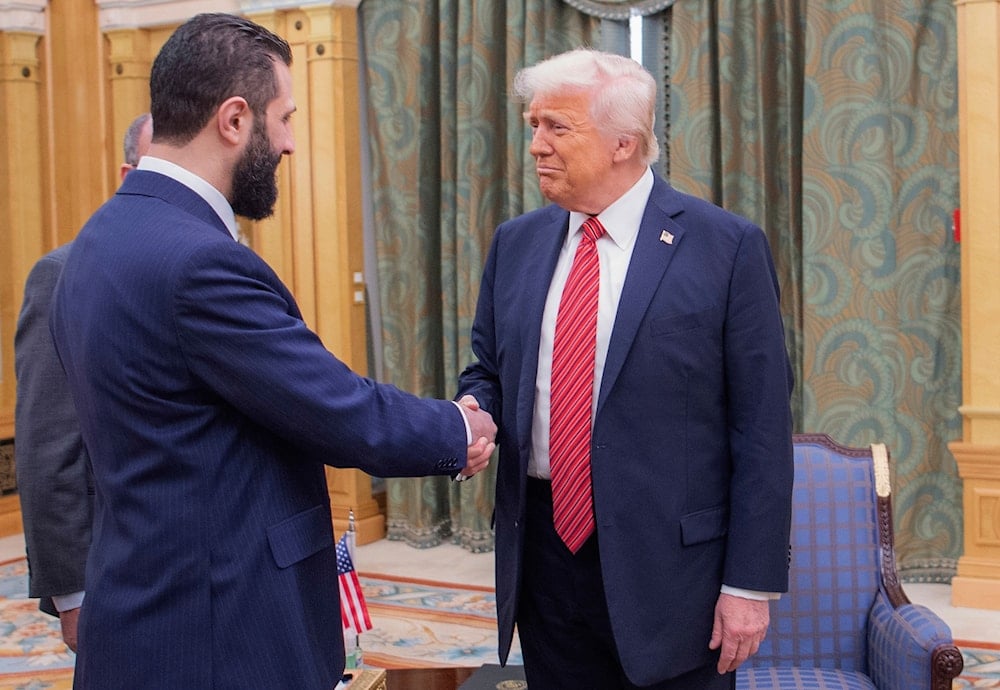Trump lifts sanctions on Syria, then slaps country with 41% tariffs
After lifting sanctions, the US hits Syria with 41% tariffs, risking reconstruction efforts, trade ties, and Gulf investment amid ongoing instability.
-

US President Donald Trump, right, shakes hands with Syria's interim President Ahmad al-Sharaa, in Riyadh, Saudi Arabia, May 14, 2025 (AP)
Three months after US President Donald Trump stunned the world by announcing a complete lifting of sanctions on Syria, he hit the country with the highest tariff rate among the countries he's targeting with his levies: 41%.
Due to longstanding US sanctions, trade between Syria and the United States remains minimal, though not entirely nonexistent, with Syria exporting goods worth $11.3 million to the US in 2023, according to the Observatory for Economic Complexity, while importing $1.29 million worth of American goods, resulting in a trade deficit for the US relative to the economically struggling Middle Eastern nation.
The tariffs implemented by the Trump administration, which were calculated using a controversial method applied to each country in April and based on trade deficit data, are intended to reduce trade imbalances, according to Trump, who has not specifically addressed the situation regarding Syria.
Giorgio Cafiero, CEO of risk consulting firm Gulf State Analytics, told CNBC, "After years of devastating civil war, the country is in urgent need of substantial foreign direct investment to begin the long and difficult process of reconstruction and development."
“While the recent lifting of many US, UK, and EU sanctions was a welcome development for Damascus’ economic ambitions, Washington’s imposition of steep tariffs now threatens to restrict any potential for meaningful trade with the United States," he added.
Following the official lifting of US sanctions by the Trump administration in June, Syria has welcomed delegations from the US and wealthy Gulf states, who have pledged reconstruction support and investment, even as the country continues to face sporadic sectarian violence and repeated Israeli airstrikes.
An economy on the edge of collapse
Aid organizations report that over two-thirds of Syria's electricity grid is inoperable, leaving major cities such as Aleppo and Damascus without power for more than 20 hours daily, while many rural and conflict-affected areas have no electricity access whatsoever.
H.A. Hellyer, a senior fellow at the Royal United Services Institute in London, noted that Syria's economy is not merely struggling but has appeared dangerously close to collapse in recent months, emphasizing that without immediate and decisive intervention to stabilize and revive it, the situation could worsen further.
Qatar recently revealed a humanitarian initiative, involving its development fund acquiring gas and delivering it to Syria through Azerbaijan and Turkey, aiming to assist over 5 million people while potentially increasing daily electricity availability by up to 40%.
Fahad al-Sulaiti, Director General of Qatar Fund for Development, explained that Damascus would need to rely significantly on assistance from Qatar, Saudi Arabia, and the United Nations, especially since US tariffs could hinder potential trade opportunities with Syria, while also mentioning Qatar's ongoing coordination with the US government to facilitate aid efforts.
“We work very closely with our partners in the United States. That’s why from day one ... we work very close with the Treasury Department ... we’re taking with them to create a good economic system,” the director-general told CNBC.
Tool of control
Economic analysts point out that the 41% tariff will have minimal real-world effect on Syria's already crippled economy, given the extremely limited trade volume between the two nations.
CNBC quoted Giorgio Cafiero as saying that while the economic impact of the 41% tariff may be negligible, its symbolic significance carries much greater weight, particularly as Syria was singled out for the highest tariffs despite the recent easing of most sanctions. This sends a deliberate message from the Trump administration that while Washington may be open to relaxing its economic pressure on a post-Assad Syria, any such engagement would strictly be on terms dictated by the US government.
Cafiero proposed that the tariffs might serve as leverage to push Damascus toward normalizing with "Israel", despite ongoing Israeli military operations within Syrian territory. “In this sense, the economic policy resembles a kind of ‘leash,’ designed to be adjusted in response to the political behavior of the al-Sharaa government and broader developments on the ground.”
US exploits current instability in Syria
Security analysts caution that without sufficient economic, humanitarian, and diplomatic assistance, the persistent instability in certain regions of Syria could escalate into full-scale conflict and an even more severe humanitarian catastrophe.
Tom Barrack, the US envoy to Syria, has emphasized both his personal and Washington's unwavering backing for Syria and the al-Sharaa administration, while also revealing new investment programs supported by the US and Qatar aimed at the country's recovery.
While the direct economic effects of the tariffs might be minimal in the short term, Cafiero warned that their psychological and political significance could prove substantial, interpreting them as a strategic move by Washington to maintain influence over Syria's long-term trajectory.

 5 Min Read
5 Min Read








